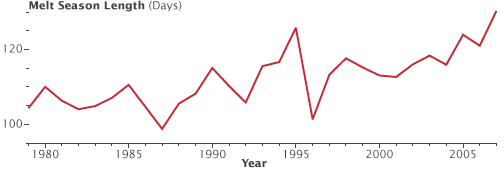Graph of the Day: Arctic Melt Season Length, 1979-2007
The icy cap over Earth’s North Pole reaches its summer minimum in September and its winter maximum in late February or early March. Satellite observations since 1979 have shown that amount of ice that survives the summer is getting smaller; declines have been especially dramatic in the past decade. Recently, scientists from NASA and the National Snow and Ice Data Center described another way Arctic sea ice is changing: the summer melt season is getting significantly longer. … The graph illustrates how the length of the melt season varies significantly from year to year, but the long-term trend is clear. … The scientists say this pattern is consistent with a climate process known as the ice-albedo feedback. Dark ocean water absorbs more sunlight than bright, reflective ice. Even a small change in the start of the melt season exposes the ocean to more incoming sunlight, which warms the water, which melts more ice, and so on. The more solar energy the ocean absorbs during the summer, the longer it takes in the fall for the water to cool down enough to freeze.
